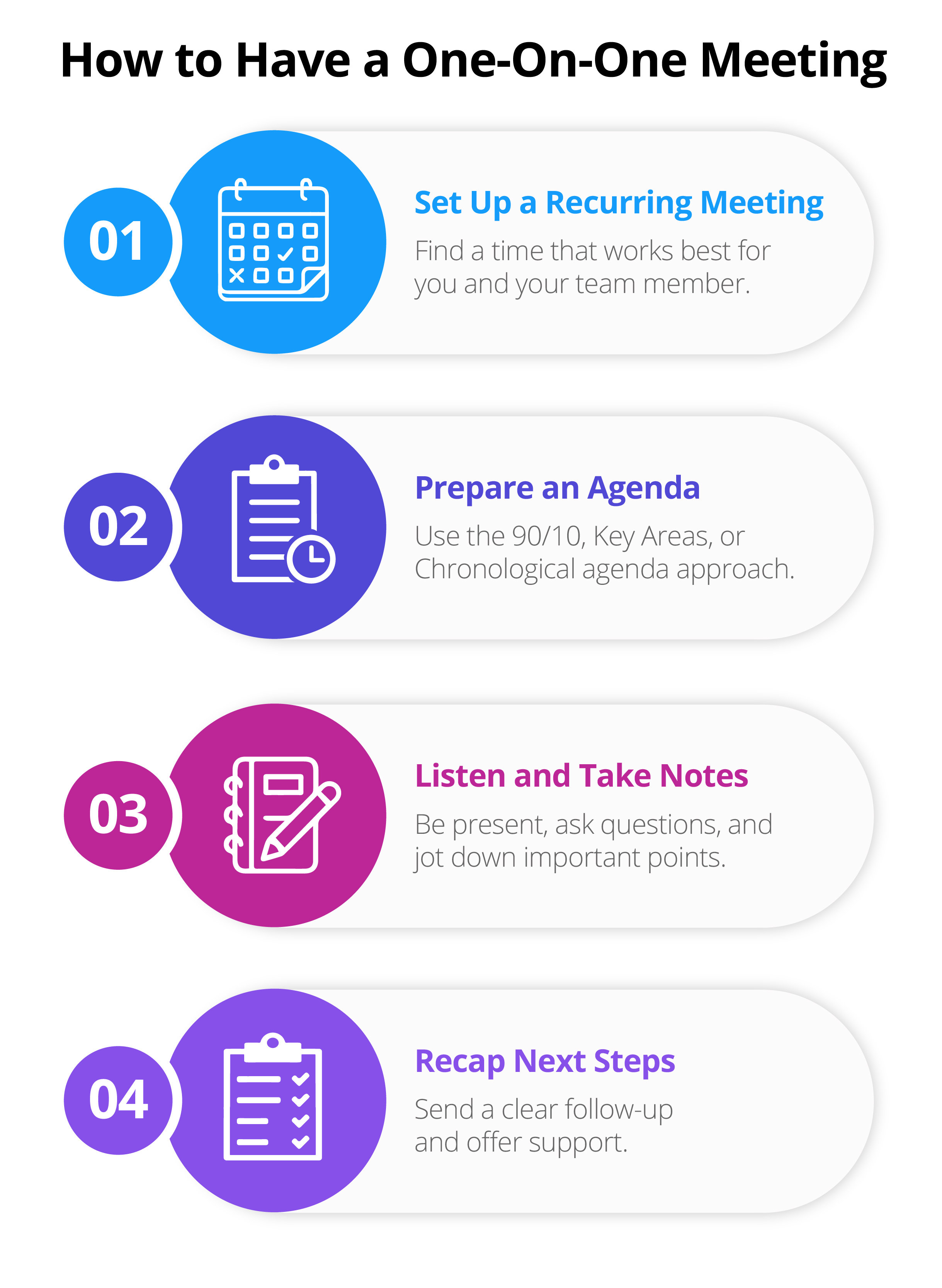Holding one-on-one meetings with your employees is an important tool for managers. These regular check-ins help ensure better communication, productivity, and well-being for you and your employee and your team and organization as a whole. If your workforce is remote and spans different countries and time zones, holding regular virtual one-on-one meetings with your employees is especially beneficial when in-person check-ins aren’t an option.
But virtual one-on-one meetings aren’t as simple as scheduling a call, tuning in, and catching up - they take thought, preparation, and active engagement to ensure a productive and beneficial conversation between you and your employee. Here are some helpful recommendations for holding one-on-one meetings with your team members.
Why Are One-On-One Meetings So Important?
While there are many benefits to having a remote workforce, it can be challenging since you can’t see your virtual employees in the office every day. Popping over to their desk to ask a quick question, chatting about their weekend plans at the coffee machine, or going out for an impromptu lunch are not options with remote employees.
However, there is a solution to cultivating that connection remotely. One-on-one meetings help you get to know your employees personally and create a safe space to exchange feedback, discuss their priorities and challenges, open up opportunities for upskilling, and explore their goals for career development. Having regular one-on-one check-ins with your employees allows you to:
Foster a Personal Connection
More face time, even if virtual, means more opportunities to get to know each other on a personal level. Establishing a deeper personal connection also invites space for more engagement, which is often highest among employees who have some form of daily communication with their managers. According to Gallup’s State of the American Manager report, employees who meet regularly with their managers are almost three times as likely to be engaged in their jobs as employees who don’t.
Maintain Open Communication
One-on-one meetings help you develop and maintain a line of open communication with your employees. According to Forbes, strong communication is one of the critical components that leads to retaining valuable team members long-term. With new hires, these meetings allow you to establish a relationship and help them better understand the company and their career goals. One-on-one meetings help established employees develop their roles further within the company. It’s also an opportunity to exchange feedback with your distributed workforce to learn what’s working and not working in a remote setup.
Ask Essential Questions
Regular check-in meetings also invite a space for both parties to ask essential questions that may not be as easy to talk about in other team meeting situations. According to a Salesforce report, employees are more than four times more likely to feel empowered to do their best work when their voices are heard. These questions can vary – from a micro-level regarding a specific task or project to a macro-level surrounding company strategy and career path. Use this time to listen, understand, and help clarify.
Discuss Important Issues
One-on-one meetings create a safe space between you and your employee and help both parties learn to address issues proactively and exchange ongoing feedback. While a one-on-one meeting is very different from an annual employee review, it’s important to use these meetings to check in on benchmarks that tie back to your employee’s overall successes, struggles, and future goals.
Establish Trust and Confidence
All of the above – personal connection, open communication, and the ability to ask questions and discuss important topics – are part of establishing an open and trusting relationship with your employees. Developing this trust and confidence is especially critical when your team is remote. Even though you can’t interact in person, one-on-one meetings show your team that they’re valued and have your confidence and support.
How to Have a One-On-One Meeting
While there are many approaches to holding a one-on-one meeting with an employee, the goal is the same: establish and grow the relationship. Here are some great ways to set up a solid foundation:
 Set Up a Recurring Meeting
Set Up a Recurring Meeting
The key to regular one-on-one meetings is to make this event a priority. Set up a recurring calendar invite, or be diligent about scheduling each meeting if the time varies. How often you meet, whether weekly, bi-weekly, or monthly, may depend on how frequently you and your employee already interact within your team. Because remote teams can span across various countries, consider time zones that are reasonable for both parties. No matter what you decide, find a recurring check-in that you can commit to and stick with.
Prepare an Agenda
Covering so many valuable topics -- personal life, current priorities and challenges, performance, and long-term goals -- may feel daunting to achieve in one meeting. However, creating a structure for the discussion will help both you and your employee find a routine groove each time you meet. Fellow’s guide, The Art of the One-on-One Meeting, suggests several different approaches to leading and setting up an agenda for one-on-ones:
90/10 Agenda Approach
The employee is responsible for 90% of the agenda, and the manager is responsible for the remaining 10% of the agenda. This reaffirms that the meeting is for the employee, and they get to take ownership and direction of the discussion. 90/10 is also a helpful approach for employees who find it easy to come up with conversation topics.
Key Areas Agenda Approach
Follow a list of focal topics that can act as prompts for discussion. This is a helpful structure for those who find it hard to come up with their own topics. Fellows suggests the following key topics:
- Top of mind
- Things that went well
- Learning
- Priorities
- Challenges and concerns
- Team dynamics
- Feedback
- Career development and goals
Chronological Agenda Approach
Discuss topics in the order of events: past, present, and future. You can start with discussing the past week's wins and challenges, then move on to immediate priorities or concerns, and finish up with discussing goals, development, and future opportunities. This may be an easier flow for those who think chronologically, and it still allows you to hit on key topics.
Actively Listen and Take Notes
It’s important to be actively present during these one-on-one meetings. Treat this remote meeting as if you were spending it together in person. Make sure there are no distractions, turn your notifications on silent, and situate yourself in a room that is free from potential interruptions.
Review the agenda ahead of time and come prepared with talking points or resources you would like to share with your employee. Take notes – jot down a few key important points during the conversation, and take some time afterward to note action items, things to remember, and topics for the next discussion. Reference these notes when you prepare for the next one-on-one and make sure to follow up on priorities and concerns that were previously discussed.
Recap Next Steps
Send a recap after the meeting to keep the tasks and goals you discussed together at the top of mind. List out action items and next steps for both parties. If you didn’t get to a planned topic during the discussion, make sure it’s on the next one-on-one meeting's agenda. It’s your role as the manager to follow up with your employee, ensure recurring one-on-one meetings take place, and offer support and guidance for your team member.
Stay Engaged With Your Remote Team
Holding virtual one-on-one meetings shows your employees that you are invested in their performance, success, and future. It encourages your remote team to stay engaged and goal-oriented. And while there are many complexities to managing an international workforce, hiring and employing your global team shouldn’t be one. A global workforce partner helps you put your supported employees’ needs first with compliant onboarding, payroll, and administration so you can focus on what matters most: your team.
Get in touch to learn more about our remote workforce solutions.
Topic:
HR Strategies



